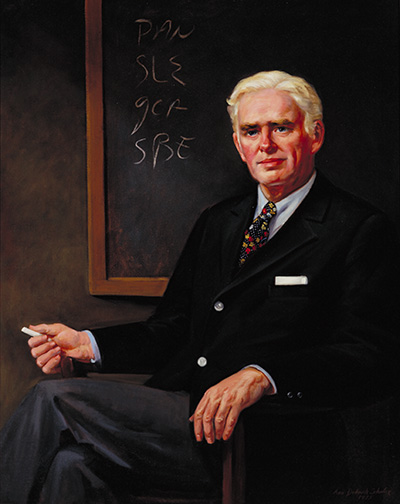The Early Years

The Division began as a small cohesive unit under Dr. Tumulty's leadership. Dr. Tumulty was nationally recognized as master clinician and teacher, and was the David P. Carver Professor of Medicine. He served on the faculty for nearly 50 years, heading the Department of Medicine's inpatient and outpatient services for 17 years. Known as an unequaled diagnostician and a champion of the humanistic approach to medicine, Dr. Tumulty focused his scholarship on the study of the natural history of disease. The author of many clinical papers on infectious diseases, he also wrote The Effective Clinician, His Methods and Approaches to Diagnosis and Care. In honor of his excellent teaching, research, and patient care, he received many awards and much recognition, including election to the Association of American Physicians. Before his death in 1989, Dr. Tumulty was honored by colleagues and patients who established the Tumulty Endowment Fund for the support of internal medicine, an area Dr. Tumulty felt important in an age of increasing specialization.
Dr. Craig Smith, a former Assistant Chief of Service, who had advocated for creating the Division, was named Associate Director. Together, Drs. Tumulty and Smith sought to build a division of outstanding general internists on the full-time faculty, who would teach, care for patients, conduct clinical research, and serve as role models for students and housestaff.
Primary faculty recruited to the Division in the early years included Drs. Diane Becker, Laura Mumford, Tom Pearson, Brent Petty, and Lora Wilder. The Division was also the home for the four Assistant Chiefs of Service of the four Firms of the Department of Medicine. To learn more about the close relationship between GIM and the Firm System, watch Chief Rounds, a short film produced by Dr. Brancati.
One of the most important developments in the Division’s first year was the creation of the fellowship training program in internal medicine. Drs. Tumulty and Smith secured funding from the Kaiser Family Foundation for two fellows per year for two years. According to Dr. Smith, this was a seminal event in the history of the Division. It gave the Division money, credibility, and the means to attract young talent. Early post-doctoral fellows recruited to the Division included Drs. Lawrence Klein and Steve McPhee (1978) and Dr. Richard Moore (1984). These individuals established a strong multidisciplinary collegium—a hallmark of the Division to this day.
With Dr. Tumulty's retirement from full-time faculty duties, Dr. McKusick appointed Dr. Smith to the Division Director post. The Division began to grow in number of faculty and staff and to develop its clinical, teaching, and research activities. In addition to its own practice, the Division took responsibility for the University Health Service and the Department’s general medicine consultation service. The Division had also become the home for two important grants: 1) the Robert Wood Johnson Grant to establish a model practice for faculty and house staff practice in general internal medicine and 2) the National Institutes of Health (NIH) Preventive Cardiology Award, under the stewardship of Dr. Thomas Pearson, which brought initial scientific recognition to the Division. Recruitment of new faculty and fellows was underway, and Drs. Smith and David Levine—then a joint faculty member, with a primary appointment in the School of Public Health—recruited Dr. Earl Steinberg to develop and head a program in Health Policy and Technology Assessment. They also recruited GIM fellows to Dr. Levine’s NIH training grant in Behavioral Aspects of Heart and Vascular Diseases, which has been continuously funded since 1976.
The fellowship class of 1982 included four young physician scholars who went on to become nationally recognized leaders: Dr. Richard Allman (now Professor of Geriatrics at UAB), Dr. Linda Fried (now Professor and Director of Geriatrics at Johns Hopkins and a member of the Institute of Medicine), Dr. Michael Klag (now Dean of the Bloomberg School of Public Health), and Dr. Teri Manolio (now Senior Advisor to the Director of Population Genomics at NHGRI/NHLBI). In 1984, Dr. Smith recruited Dr. David Levine to become a primary faculty member in the Division.
